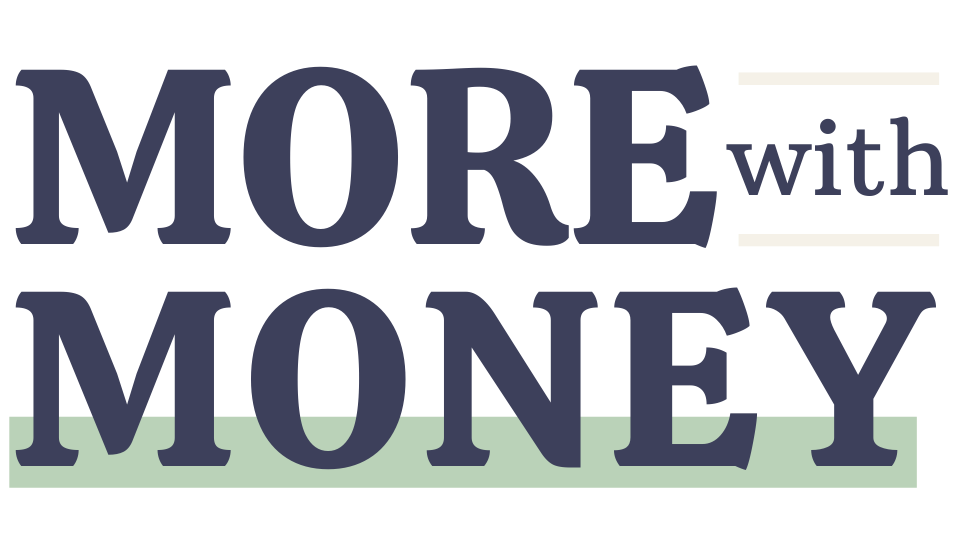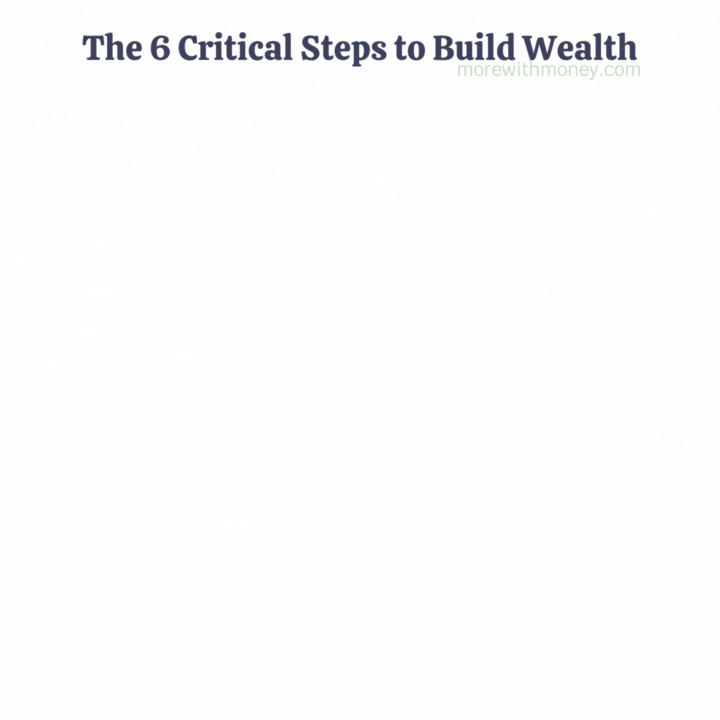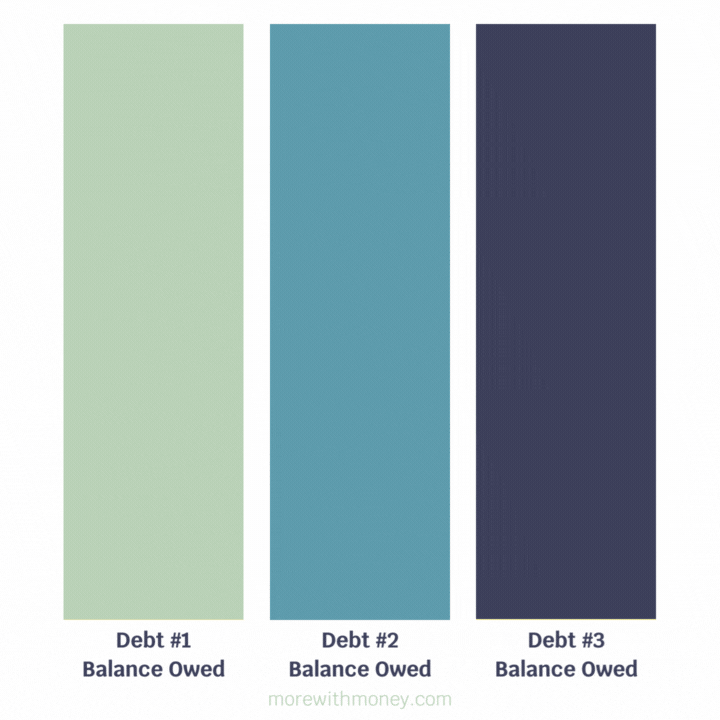How to Free Your Wealth Faster with a Progress-Boosting Debt Payoff Strategy
Paying off debt is often a long and exhausting journey, and different financial sources will teach you conflicting strategies for what order to pay off your debt. In this post, we'll explore what will actually help you speed up your debt payoff journey, regardless of which order you choose to do it!
Debt is Suffocating Your Wealth
Debt holds you back financially and emotionally!
It keeps you stuck in the past, making payments on yesterday's problems and decisions when you've got things like today and tomorrow to worry about. Anytime your cash is tied up elsewhere, that puts you at risk for whatever could be headed your way next.
As author J L Collins said in his book, The Simple Path to Wealth, “debt is the single most dangerous obstacle to building wealth”.
What to Do Before Paying Off Debt
Do the foundation work first. Just focus on paying your monthly minimums until you’re ready to tackle your debt more intentionally. Click here to read The 6 Critical Steps to Build Wealth the Smart and Stable Way.
That said, please do the extra work of running the numbers to ensure your minimum payment outpaces your accrued interest.
Student loans infamously will have you pay minimums that don’t. I can’t tell you how many times I’ve heard of people who paid on their student loans for years before realizing their total balance owed still went up from where they started. If your minimums don’t cover your interest, set a higher monthly payment goal for that debt.
From this point forward on your debt payback journey, you do not want to go into more debt.
When you’ve read the post linked above and determined that you’re ready to accelerate your debt payoff journey (and get debt-free as FAST as possible, with the exception of your mortgage unless you want to include it in this), you need to create a plan. Here’s how to do it…
The Debt Payoff Strategy
Step #1: Gather Information
To make a plan, you need to gather your information and numbers for all of your debts. You do not have to include your mortgage in this plan (most people tend to prioritize this later in their wealth journey), but if you want to you can!
Here’s the information you’ll want to collect:
Name of Lender: This may be the credit card company, student loan servicer, mortgage broker, etc. Have this list on hand so you know where to log in, who to contact, etc.
Remaining Balance: How much you currently owe on each debt as of today. This is 10x easier if you’re no longer adding to your balances (especially with credit card usage).
Minimum Payment Amount: What’s the minimum you need to pay on each debt each month in order to stay ahead of the interest you’re accumulating? If you can’t tell, write down the current outstanding minimum payment you have due.
Interest Rate: This number will tell you how expensive your debt is. Try to be as accurate as possible. If there are multiple rates (such as with student loans or credit card promotional periods), you might want to try and list them out as separate debts.
Other Details: Type of debt, login details, contact information, payment due dates
Step #2: Understand the Core Strategy
There are different schools of thought on how to prioritize your debts when paying them off, and we’ll take a look at those in a moment. But, at the end of the day, which prioritization plan you follow matters significantly less than the core strategy of focusing and rolling over your payments.
Focus: Every dollar you can spare goes towards debt, but you’re specifically going to focus on throwing your extra money at one debt at a time. You’ll pay your minimums on all debts so you’re not going into more of it, but your accelerated debt paydown focus is on just the one.
Roll Over: Once the first debt is paid off, you’ll then roll over the TOTAL contributions you were making to that debt (Minimum + Extra) into Debt 2. It can be tempting to use the cash you just freed up to raise your standard of living, but you’ll make exponentially faster progress if you “reinvest” all the money that was going towards Debt #1 into paying down Debt #2 even faster.
So it’ll look something like this:
The question then becomes - which of my debts is Debt #1? Let’s break down the approaches.
Step #3: Prioritize Your Debt Payoff
The Debt Avalanche Method (Highest Interest Rate)
The Debt Avalanche teaches you to pay off the debt with the highest interest rate first with the goal of reducing the amount you'll pay in interest in the long run. So you would focus your efforts on the following debts like so:
Credit Card A — $10,000 Owed — 22%
Credit Card B — $3,000 Owed — 19%
Student Loan — $15,000 Owed — 5%
Car Loan — $9,000 Owed — 3%
The Debt Snowball Method (Smallest Balance)
The Debt Snowball method, popularized by financial expert Dave Ramsey, teaches you to pay off debt with the smallest balance first. The idea is that you'll get the "quick win" momentum that will appeal to the human behavior side of finance and help you stick it out for the long haul. With this method, you reorder your priorities like so:
Credit Card B — $3,000 Owed — 19%
Car Loan — $9,000 Owed — 3%
Credit Card A — $10,000 Owed — 22%
Student Loan — $15,000 Owed — 5%
Which Method is Actually the Best?
This totally depends on who you ask! Some financial experts insist on the Avalanche method, and some insist on the Snowball.
Studies have shown that, while you would save more money with the Avalanche method, you're more likely to actually complete your debt-payoff journey and become debt-free if you use the Snowball method (or its fundamentals in the Hybrid method, below), due to its catering to human motivation.
Back to the other side, other experts would tell you that you should just be more disciplined to pursue the Avalanche method rather than trying to play games with behavior science.
The choice is truly yours. In fact, you may even want to adapt and create your own hybrid approach:
If you have two debts with relatively similar balances, you may place the highest interest one first.
If you have a debt with a ridiculously high-interest rate, you may prioritize that first even if the balance is high.
If there’s a debt you have that is more of an emotional burden than the others, you may want to prioritize getting rid of that one first regardless of the math.
Again, the main key is to be able to focus all of your energy on one debt at a time. If you’re making all of your other minimums and throwing everything extra that you have at the debt that burdens you the most or would give you the most momentum, it’s not as important which debt that is.
Finance is both mathematical AND behavioral. So always consider both sides.
Your Next Steps
Click here to read The 6 Critical Steps to Build Wealth the Smart and Stable Way to make sure that you have the foundations you need to SAFELY be able to start your debt payoff journey.
Gather your debt information and formulate your prioritization plan. While you can create this plan fairly simply with a piece of paper and some basic math, you can create a more detailed plan with something like this Vertex42 Debt Reduction Calculator (free). That is also a great resource to compare what your debt payoff journey will look like with different prioritization methods with a simple click of a dropdown button!
3. Check out the More With Money Academy and take your financial journey to the next level!
This ever-growing collection of online courses and trainings are specially designed to support entrepreneurs like you on your path to financial wellness. The Academy contains carefully designed courses that are easy to understand and implement so that you can be empowered with the practical concepts, streamlined systems, and powerful mindset to transform your business and personal finances.
Click here to explore what the More With Money Academy has to offer!
Pin for later
I'd love to continue the conversation in the comments! Feel free to share your thoughts.
Until next time!






